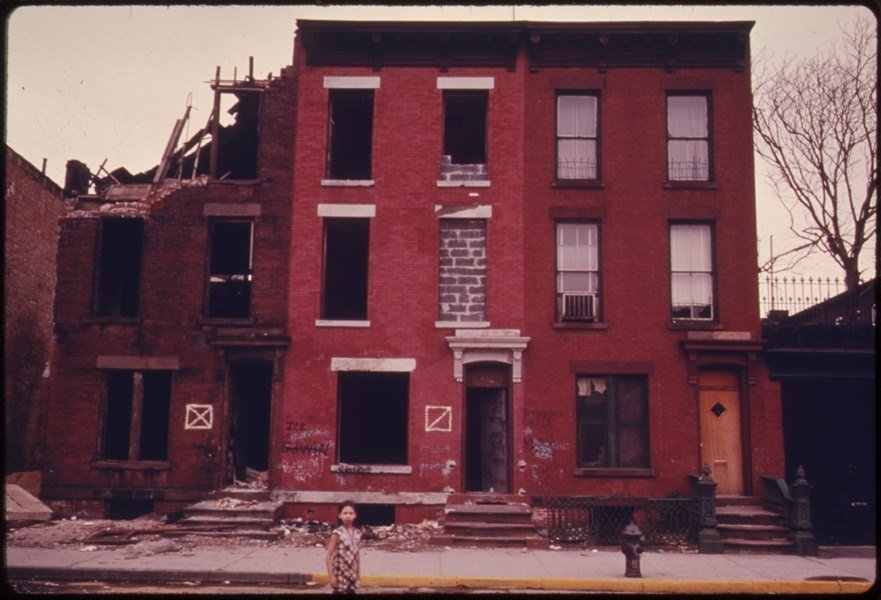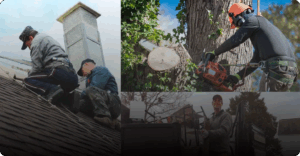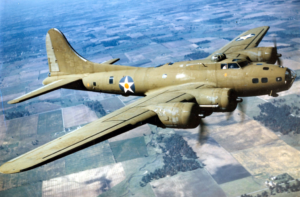Brooklyn wasn’t always hipster heaven. During the 1940s and 1950s, Brooklyn was a thriving manufacturing community, where working class Americans could find a good job and a solid place to raise a family. But when those companies started leaving Brooklyn for cheaper locations, an economic slump followed that lasted well into the 1990s. Today’s Brooklyn is dominated by trendy shops selling everything from mustache cream to artisan beef jerky, while its quaint homes have been replaced by luxury condos and skyscrapers for the super rich.
Below, we have compiled 17 photographs that demonstrate what it was like in the 1960s, 1970s and 1980s, before Brooklyn became the hottest zip code in New York.
Brooklyn Home Falling Apart – 1966

As the boom years, ushered in by World War II, faded, Brooklyn’s manufacturing base cratered. The most serious blow of the 1960s was the closure of the Brooklyn Navy Yards in 1966. Nearly 11,000 people lost their jobs, causing many homeowners to let their homes fall into disrepair.
Brooklyn Bridge in the Fog – 1986

Brooklyn experienced the same problems that the rest of America did during the 1970s and 1980s, with long lines to buy gasoline and rising inflation. Artist Allan Tannenbaum, who took this photograph, reminisced about the deteriorating conditions around the city, leading to the abandonment of cars like this one. He wrote that in Bed-Stuy, “It seemed as if the entire infrastructure was in decay.”
Fort Greene Row Houses – 1974

The collapse of industry and the wider economy of the 1970s resulted in escalating crime rates in Brooklyn. Residents of places like Fort Greene felt like they were under siege, as organized crime and gangs moved in, bringing drugs and violence with them. One proposed NYPD campaign would have published posters for tourists which were titled “Welcome to Fear City,” with a long list of places that were too dangerous to visit. The poster was never published, but the fear of crime was real. The murder rate was four times higher in 1974 than it would be 20 years later in 2014.
Carlo Gambino’s Funeral – 1976

Bearded hipsters rule the streets in modern Williamsburg, but in the mid-1970s the Italian mafia ran things from their headquarters on Graham Avenue in Williamsburg. When mob boss Carlo Gambino died in 1976, mourners lined the streets. Sonny Black ran the Bonanno crime family, which had deep roots in Brooklyn, while many Sicilian mobsters spent decades in the neighborhood.
Death Outside Joe and Mary’s Italian Restaurant – 1979

In 1974, Carmine Galante took over the Bonanno crime family, steering the organized crime syndicate deep into the world of drug trafficking. His daring rise to power made many enemies among New York’s other mafia families, and Galante was murdered outside of Joe and Mary’s Italian restaurant in Bushwick in 1979.
Kosciusko Pool – 1974

There was a mass migration of people leaving Brooklyn in the early 1970s and Brooklyn’s overall population has never recovered. However, Brooklyn continued to be a safe haven for immigrants who moved to the USA in search of the American Dream. In 1970, over 460,000 of Brooklyn’s residents were foreign-born. By the year 2000, the number had increased to nearly 1 million.
Brooklyn Academy of Music – 1978

New York has more African-American residents than any other city in America. When the A-train extended service from Manhattan to Brooklyn, it opened up new opportunities for African-Americans to settle in the the Bedford-Stuyvesant area. But in the 1970s, many affluent African-American families departed the borough for Queens. Meanwhile, the city’s poorest residents were left to cope with a declining community.
City Blackout – 1977

One of the most infamous events of the 1970s was the city-wide blackout which occurred on July 13, 1977, after a lightning strike brought down power stations in New York. It took only 24 hours for arsonists to set 1,000 fires, while looters raided 1,600 businesses. The fallout from the blackout was catastrophic, causing $300 million worth of property damage.
Aftermath of Blackout – 1977

No areas of the city were hit harder than the Bronx and Brooklyn, where homes were broken into, cars stolen, buildings torched, and businesses looted. The New York Daily News reported that extensive looting took place all along the 20-block stretch of Flatbush Avenue, between Church and Lenox and Utica Avenue.
Brooklyn in Summer – 1977

The summer 1977 was already filled with tension and dread. The serial killer known as “Son of Sam” was killing people and the police seemed powerless to capture him. After a summer of paranoia and fear, police identified David Berkowitz as the killer, and he was arrested in August.
Family Time in Carroll Gardens – 1978

Despite the many difficulties of living in Brooklyn at the time, some areas of Brooklyn underwent a mini-renaissance. A movement to restore certain neighborhoods became popular by the mid-1970s. The so-called “Brooklyn brownstone movement” saw urban activists reclaiming houses and businesses in neighborhoods like Park Slope, Cobble Hill, and Carroll Gardens.
Rockaway Beach – 1978

Brooklyn has always been welcoming to immigrants. When the Soviet Union relaxed their immigration policies in the 1970s, it opened up new opportunities for Russian immigrants to move to America. Many people from Russia and its states moved to the Brighton Beach and Coney Island areas.
Graffiti – Date Unknown

The 1980s brought a new threat to the area, as crack cocaine became the drug of choice, sparking a terrible epidemic all over the nation. This graffiti contains a warning for Brooklyn that “Crack Kills.”
Brooklyn – 1986

The surge in drugs also brought about a rise in violence, as gangs, the mob, and newcomers fought over drug territory. This prompted activist Luis Garden Acosta to describe North Brooklyn as the “killing fields” because so many teenagers were being murdered in gang-related incidents.
Police in Crown Heights – 1991

During the early 1990s, racial tensions ran high and there were riots after an incident between the African-American and Jewish communities in Crown Heights. After the riots, locals formed the Crowne Heights Coalition to promote cross-cultural understanding and improve relations between the police and the residents.
Funeral of Notorious B.I.G. – 1997

Like Italian-Americans before them, African-Americans banded together to form tight-knit communities in Brooklyn. When rapper Notorious B.I.G. was murdered in 1997, the entire neighborhood of Bedford-Stuyvesant gathered to celebrate his life.






